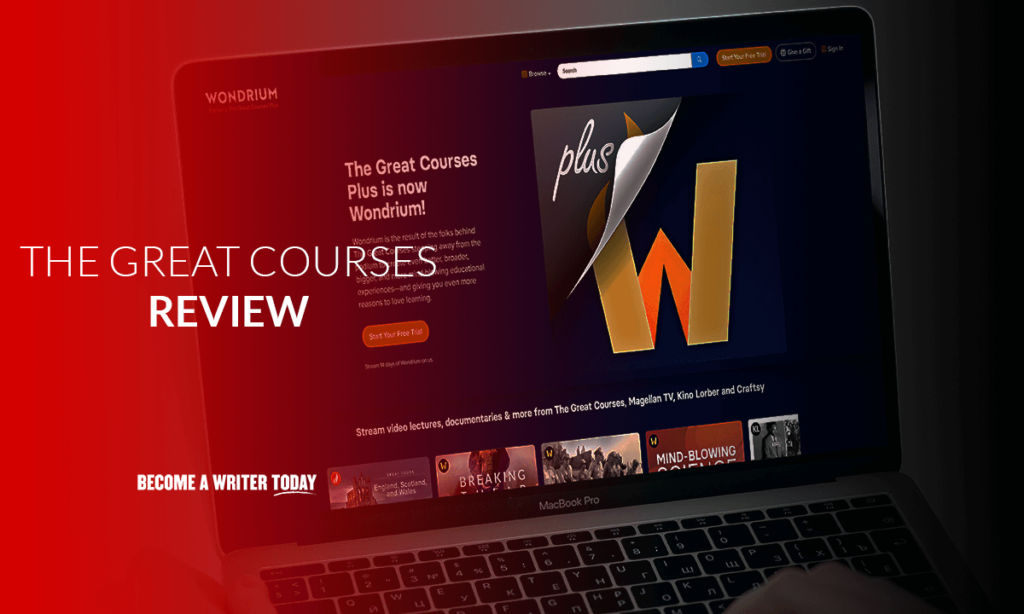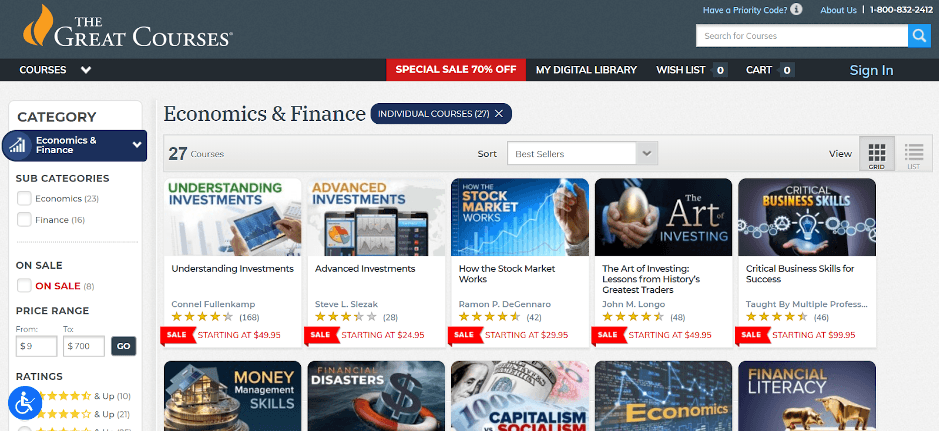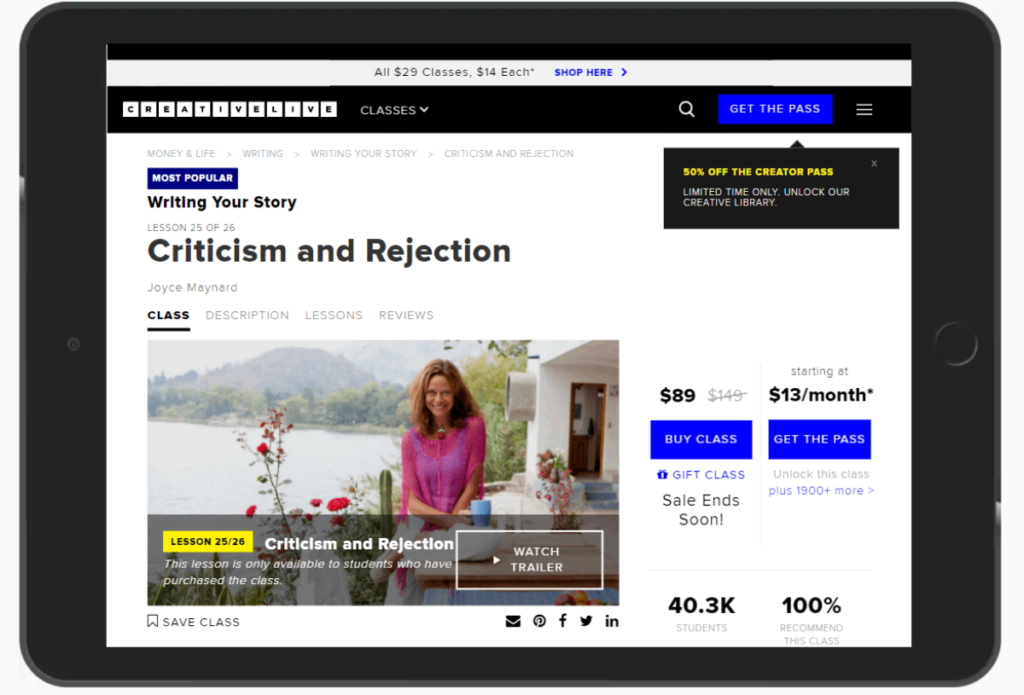The Great Courses is the granddaddy of these types of learning opportunities, but where do Great Courses Plus and its rivals fit in?
No Great Courses Review should start without marveling how dramatically the quality of “learn at home” options has improved in recent years. But while technology has carried us well beyond books on tape, it has also brought us a sometimes confusing number of non-degree educational platforms, each with its own pros and cons.
Ultimately, which one — or more — online education platform you choose will probably have less to do with its bells and whistles than whether the format feels comfortable to you. But before you take out your credit card, consider questions such as your preferred learning style and whether you prefer total access for a monthly fee, or the ability to pay as you go.
Contents
Who Should Take the Great Courses?

So — who should invest in The Great Courses or The Great Courses Plus? It’s usually people who seek to enrich their understanding of the world or to brush up on certain professional skills who consider it.
No Great Courses review would be complete without mentioning the longevity of its parent company, The Teaching Company. Its founder, Tom Rollins, ultimately created the Great Courses and Great Courses Plus family of classes and lectures on the premise that people want to keep learning about specific topics without necessarily seeking a degree or going to a physical classroom.
The Teaching Company now has hundreds of employees and thousands of hours’ worth of courses and individual lectures. Although it started in an era before people could go online and watch YouTube lectures and TED talks, Great Courses has stayed competitive by offering the option of buying individual classes through physical tapes or DVDs or to stream them online.
The Great Courses vs. the Great Courses Plus
For any The Great Courses Plus review or regular Great Courses review, it’s important to note what is similar and what is different between the two options.
The biggest difference is that the “original recipe” Great Courses is “à la carte,” allowing you to buy classes and lectures individually as one-time payments. Great Courses Plus is a streaming service, meaning that you pay a monthly fee but have access to thousands of streaming videos.
If you like the quality of Great Courses, the main difference will come down to whether you’re a person who doesn’t like the commitment of a monthly bill and who doesn’t expect to want access to more than a couple of courses and lectures each year, or whether you feel the monthly fee is worth it, given the number of courses you plan to pursue.
If you’re an avid learner, the savings potential of Great Courses Plus can add up fast. If you’re into “Understand the Universe,” for example, buying the 96-lecture course à la carte on the original Great Courses can cost close to $700. But it’s included in your membership at no additional cost if you belong to Great Courses Plus.
The Great Courses Plus Review
So, what IS the pricing structure? This review of the Great Courses Plus looks at the current pricing. While it’s fluctuated since its launch, the current subscription rate is at bargain-basement levels, with an option of $19.99 a month, or $45 when paid quarterly. (That means an annual outlay of about $240 with the monthly plan, or $180 with the quarterly plan.)
Given that a single Great Courses unit can cost about $240 when bought individually, the Plus option definitely can pay for itself quickly. The streaming service offers apps on a number of devices for the cost of membership, including Roku, Google Play and Kindle Fire. That kind of accessibility should be noted in any The Great Courses Plus review.
Not surprisingly, many of the offerings on Great Courses Plus and Great Courses overlap. Both break down the general subject matter into about a dozen categories, including Science, Music, Religion and Literature. Both have categories for adult professionals and for younger learners.
But Great Courses Plus also has a large stable of individual lectures, along with multi-class courses.
As with many of the platforms examined here, what first looks like a treasure trove of offerings on “writing” includes subjects that turn out to be only tangentially about the art of writing. That’s the case with a class called “The Shang and Writing for the Gods.” While this looks to be a fascinating subject — about oracle bones and ancient Chinese writing — it’s not exactly germane to the topic.
There are also about 30 lectures on the topics of various aspects of writing, including dialogue, getting over rejection letters, starting first drafts, editing, short story writing, essays, and pitching your work to publishers.
The Great Courses Review

This Great Courses review will show you how it differs from Great Courses Plus. Primarily, the basic Great Courses is a format in which you buy individual classes as you need them, rather than paying on a regular basis for access to the entire catalog (the Great Courses Plus system).
The individual classes are available in your format of choice, including CD, DVD, and digital options like Audible.
Diving Into Classics
Using the company’s Music category as an example for this Great Courses review, consider two of its “Great Masters” courses, both taught by Professor Robert Greenberg, Ph.D., a Great Courses favorite. “Beethoven ‒ His Life and Music,” and “Mozart ‒ His Life and Music,” are both available for $89.95 for audio and $199.95 for DVD. (The Beethoven class also has the option of a video for $169.95.)
With your purchase of either course, you’ll get eight lectures at about 45 minutes each, along with a substantial course guidebook (physical copy with the DVD or downloadable PDF document with the audio and video options). You’ll learn about each composer’s life and how it influenced his compositions. While some students might be thrown off by the lack of a straightforward timeline, Greenberg’s lively teaching style and humor keep you engaged.
Don’t Forget Your Inner Self
What about something a little more in the line of self-improvement? “Cognitive Behavioral Therapy: Techniques for Retraining Your Brain” can give you another side of the platform in this Great Courses review.
The course is designed to break self-destructive habits and thought processes through CBT. In its simplest terms, CBT can safely place you in the moment of a situation that normally tends to make you spiral into negative patterns.
With the help of the course, however, you’ll learn how to choose a more positive reaction to the situation. Many of the classes deal with specific challenges, including addiction, weight gain, chronic pain, anger, and depression.
The group of 24 half-hour lectures is currently offered for $49.95 for the video and $69.95 for the DVD, along with a guidebook for both formats. The class is one of the better-reviewed self-improvement courses on The Great Courses and for good reason. The techniques offered are easy to follow and powerful. To top it all off, the course follows three clients undergoing their own challenges and sees them learn to apply CBT in real-time.
Looking for Writing Courses?
Great Courses has a handful of listed courses that are either explicitly or adjacent to boosting your writing skills. Lessons that apply to various aspects of writing and communication include courses on both fiction and nonfiction, from writing for beginners, writing best-selling novels to crafting great essays, and creating screenplays.
Any Great Courses review of its writing courses should also point out that you’ll find plenty of classes on the fundamentals of the skill, even down to sharpening your grammar skills. Courses like “Building Great Sentences” and “Building a Better Vocabulary” are part of the catalog.
The Great Courses vs. LinkedIn Learning
Formerly known as Lynda.com, LinkedIn Learning offers the same format and courses as the original Lynda.com. Not surprisingly, given its LinkedIn affiliation, LinkedIn Learning is focused on improving career skills. Its three main categories of courses are “Business,” “Technology” and “Creative.”
Back to Basics
The “vibe” of the website could not be more different from Great Courses or the other online education platforms looked at in this review. The clip-art graphics and stock photography clue you in — this is not the place to come for inspiration on writing or to learn how to interpret Renaissance painting.
Depending on what device you’re using, you may also find that the site itself is not as nimble as it could be, making exploring what LinkedIn Learning has to offer a bit of a navigational chore.
On the other hand, because it has such a narrow focus, LinkedIn Learning boasts a catalog offering substantially more courses dedicated to business skills than you’re likely to find on the other platforms explored here. Indeed, it specializes in courses that walk people through specific software programs or in how to perfect their sales and marketing skills.
That’s not to say that all LinkedIn Learning classes are on the dry side. The “Creative” section has courses on animation, photography, video, web design, and more. Most have a decidedly business-focused slant, so if you’re looking for a one-stop shop for life enrichment beyond work, LinkedIn Learning may not be for you.
Pricing Structure
LinkedIn Learning offers you the choice to be either billed monthly at $29.99 or for an annual fee of about $240. There are also courses that you can access only if you upgrade your LinkedIn account to “Premium,” so the potential for a bait-and-switch experience may await you, depending on the courses you want access to.
Although LinkedIn Learning is geared toward professional growth, it doesn’t offer accreditation upon completion of a course. But you do get a special certificate you can put on your own LinkedIn page. Would-be employers aren’t apt to mistake this for an actual degree, but it does indicate your dedication to building skills.
Overall, there’s not much overlap between The Great Courses and LinkedIn Learning, other than The Great Courses’ “Professional” category, which currently lists 80 courses. If you’re mostly interested in marketing yourself, improving proficiency on various software programs, and learning office-related skills, LinkedIn Learning, with its 14,000 courses on professional skills, clearly has the edge.
The Great Courses vs. MasterClass
While the online course provider MasterClass does offer courses with substance, its big draws are the celebrity names and splashy production values it brings to the table — and its emphasis on helping you unlock your creative side. MasterClass’s instructors may not be in the position to lecture you on ancient Greek myths for hundreds of hours, but they can certainly be passionate about their respective fields in easily digested bites of 10 minutes at a time.
Big Names, Big Gains?
Here you’ll find celebrated figures like Martin Scorsese, Annie Leibovitz, Steve Martin, Steph Curry, David Mamet and James Patterson teaching aspects of their celebrated careers.
Recent additions on the site’s main page reveal Serena Williams on tennis, Itzhak Perlman on violin, Diane von Furstenberg on fashion, Jane Goodall on conservation, David Sedaris on storytelling and humor, Bobbi Brown on makeup, Danny Elfman on music in film, Gordon Ramsey on cooking, Penn and Teller on magic, and Garry Kasparov on chess.
Other leading lights on aspects of different genres of writing include Aaron Sorkin, Joyce Carol Oates, Billy Collins, Judy Blume and David Mamet, among many others.
Each “class” within a course is generally no more than 10 minutes long. The course averages about 20 of these fast-paced classes. To further entice you, MasterClass’s main page has splashy video packages as an “overview” of each category of courses. These not only get you revved up for learning (and subscribing), but they will give you a better taste of what’s available.
Choosing Your Learning Style
MasterClass works as either an à la carte service or as a subscription service. An “all-access pass,” which is promoted heavily on the site, is currently priced at $180 billed annually, which works out to $15 a month. In contrast, a single class can be about $90 or so.
If you think it will take you a long time to get through one class, buying it individually will save you money. But if several MasterClass offerings look good to you, the all-access pass will pay for itself quickly.
“Well, Excu-u-use Me!”
As an example of a dynamic course, “Steve Martin Teaches Comedy” takes you through examples of perfecting comedy across several of the genres with which he’s proficient, from standup to screenwriting. He and a group of affable would-be humorists work in their own pieces in some of the classes. In others, he discusses tips on gathering material, dealing with hecklers, writing and editing — and then editing some more. In all, there are 25 classes in the Steve Martin course.
Getting an Overview
Of course, not every MasterClass offering will be as in-depth. Some instructors may be too inclined to simply “hold forth” on their subject of interest without going very deep, especially if they don’t have any experience teaching.
Because MasterClass has the potential to be a bit hit-or-miss and the number of classes isn’t as high as some of its rivals, it might be best to consider this as a potential secondary source of learning. If you have the funds, invest in the “all-season pass” for a fairly reasonable $180 for the year. Or purchase a class or two from instructors whose work you’ve long admired.
The Great Courses vs. CreativeLive

CreativeLive is a bit more like MasterClass than Great Courses, but it does come with the added incentive of free classes to give potential students the feel of this alternative online education platform. Like MasterClass, CreativeLive caters to people who want to develop their artistic sides, whether on a hobby basis or as professionals.
Making Your Hobbies Pay
For those seeking to build a business or go further in their fields, CreativeLive also focuses on the skills side of creativity. For example, in the “Vlog Like a Boss” course taught by Amy Landino, people who hope to create income via platforms like YouTube can learn the basics of video production. (Landino, whose “AmyTV” channel has almost 370,000 subscribers, is essentially an online life coach for her numerous viewers.)
The competitive world of YouTube means that content providers must learn how to be charming on camera, create eye-catching graphics, and layer in on-point music — all while managing the channel itself. In her CreativeLive course, which totals about five hours, Landino breaks down these lessons into easily digestible modules of no more than 10 minutes each. She also brings to this CreativeLive experience a lively presentation style, a studio audience, and high-definition filming.
It’s a good example of CreativeLive’s offerings, which are designed to be both inspirational and practical when it comes to the “softer” skills related to creative pursuits.
Unlocking the Pricing
Frustratingly, CreativeLive’s version of the “all-season pass” isn’t always available or consistently priced. As of early 2020, they were listing a “limited-time offer” of either $39 a month or a one-year price of $149, down from $299.
Otherwise, you can buy CreativeLive classes individually. In the art and design category, prices range from $18 to $69. On occasion, there’s a third option, which involves a flash sale of a “bundle” of classes on the same topic. If you can’t decide on which class to take for “wedding DIY tips,” for example, you can bundle five classes on the topic for $99, rather than the total of $165 they would cost individually.
The Final Word about The Great Courses Review
Any The Great Courses review, The Great Courses Plus review, or other online learning platform consideration should start with your own learning style. Do you feel more engaged by formats like the Great Courses, which put you in a classroom for substantive lectures? Or, are you drawn to a lighter, brighter set of classes taught by household names, as with Masterclass?
Or you might be so focused on your career or crafting that LinkedIn Learning or CreativeLive, with their narrower focus, becomes the obvious choice.
Your best bet is to take advantage of the free trials offered by most of these platforms to get a feel for the ones that look the most interesting to you.
Got more questions about this review? Ask me below.